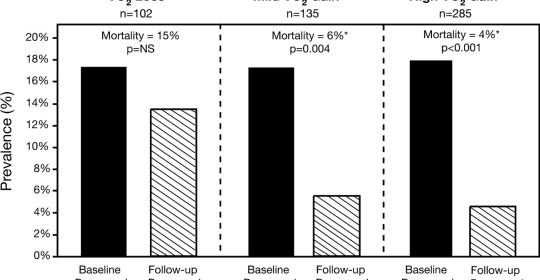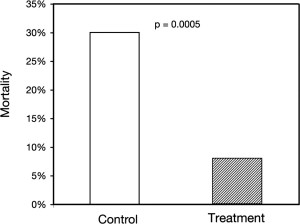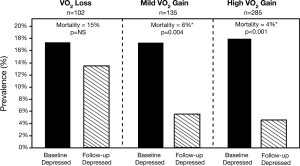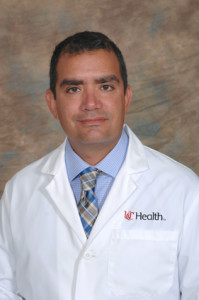
Awareness, Referral, and Multidisciplinary Approach Key to Positive Outcomes in Cardiac Rehabilitation
A recent study of over 2,000 patients clearly demonstrated that patient participation in cardiac rehabilitation (CR) after percutaneous coronary intervention (PCI) was associated with a significant reduction in mortality rates.1 A large national survey, however, estimated that only an average of 28% of eligible patients were receiving CR.2 This underutilization is due to many factors, but institutions like the University of Cincinnati Medical Center are focused on improving that percentage. Justin Dials, PhD, recently-appointed Director of Cardiopulmonary Rehabilitation and Wellness, says, “At large teaching hospitals, we need to realize that it’s incumbent on us to lead the efforts in cardiac rehab.”

Impact of cardiac rehabilitation and exercise training on mortality in 139 patients with baseline depression. From Am J Med, with permission.5
Dials reports that there are numerous barriers to patient participation in CR nationwide and worldwide, including high patient dropout rates due to geographic inaccessibility, poor social support, low health literacy, poor functional capacity and high insurance co-pays.3 One study reported that women and the elderly, who tend to have reduced exercise capacity at entry into rehabilitation, are even less likely to take part in CR.4 Those data are particularly noteworthy because these patients constitute an increasingly larger proportion of those with myocardial infarction (MI) and can unequivocally experience great physiologic benefits from cardiac rehabilitation.4
Another barrier, and one that UC Medical Center is committed to overcoming, is awareness among the professional population. Due to multiple topics that must be covered in medical school, CR is often considered a low priority and is seldom taught. Dials says, “Increasing awareness is key, whether it be in the cardiac catheterization lab, among residents and fellows, or in outpatient clinics.” There are evidence-based results that support cardiac rehabilitation’s positive impact on clinical, behavioral and health outcomes. Fostering and maintaining creative approaches to enhance provider awareness is imperative to solidify cardiac rehabilitation’s usefulness as a preventative cardiology tool.
Dials estimates that between 30%-40% of eligible patients at UC Medical Center take advantage of its Cardiopulmonary Rehabilitation and Wellness program, a comparison that has a slight edge over the 28% of eligible patients estimated to participate in CR nationwide.2 This level of engagement is bolstered by the program’s multidisciplinary, comprehensive approach. “We are active in the coordination of care, whether a patient needs help from a nutritionist or a mental health professional. Our staff is trained to facilitate those interactions, as opposed to providing simple recommendations,” says Dials. In addition, Cardiopulmonary Rehabilitation and Wellness at UC Medical Center incorporates core components to optimize cardiovascular risk reduction, follows guidelines from the American Association of Cardiovascular and Pulmonary Rehabilitation (AACVPR), and is endorsed by the American Heart Association and designated as “Class 1 – Useful and Effective” by the American College of Cardiology. Multiple studies have revealed a reduction in cardiovascular and all-cause mortality, with figure 3 showing a 70% reduction in mortality risk among depressed patients with coronary heart disease who participated in CR. In addition, CR has been shown to improve functional capacity, one of the largest predictors of mortality.5

Prevalence of depression and subsequent mortality based on changes in peak oxygen consumption (VO2) during cardiac rehabilitation and exercise training. * P <.001 compared with VO2 loss. From Am J Med, with permission.5
Another significant barrier to patient adoption of CR, however, is clinician referrals. If clinicians do not actively refer patients to CR, patients do not participate in it. There is evidence to suggest that only 20% of eligible patients are referred to CR programs nationwide, emphasizing the underutilization of these programs.3 As referrals have become largely electronic, they have become more labor-intensive and time-consuming. Easing the complexity of this referral process is one of Dials’ main goals. He is working with the UC Medical Center Medical Records staff and Information Technology Department, as well as providers, to determine the optimal method of navigating through the electronic medical record to help facilitate referrals. As the referral process has improved, more eligible patients have taken part in CR at UC Medical Center, and Dials is confident that that number will continue to rise.
References: 1. Goel K, Lennon RJ, Tilbury RT, Squires RW and Thomas RJ. Impact of Cardiac Rehabilitation on Mortality and Cardiovascular Events After Percutaneous Coronary Intervention in the Community. Circulation. 2011;123:2344-2352. 2. Pack QR, Squires RW, Lopez-Jimenez F, Lichtman SW, Rodriguez-Escudero JP, Zysec VN and Thomas RJ. The Current and Potential Capacity for Cardiac Rehabilitation Utilization in the United States. J Cardiopulmonary Rehabilitation and Prevention 2014;34:318-326. 3. Menezes A, Lavie CJ, Milani RV, Forman DE, King M and Williams MA. Cardiac Rehabilitation in the United States. Progress in Cardiovascular Diseases 2014. 56:522-529. 4. Witt BJ, Jacobsen SJ, Weston SA, Killian JM, Meverden RA, Allison TG et al. Cardiac Rehabilitation After Myocardial Infarction in the Community. JACC September 2004; 44(5):988–96. 5. Milani RV, Lavie CJ. Impact of cardiac rehabilitation on depression and its associated mortality. Am J Med. 2007; 120(9): 799-806.

Justin Dials, PhD
Director of Cardiopulmonary Rehabilitation and Wellness
Phone: (513) 558-1094
Email: Justin.Dials@UCHealth.com

